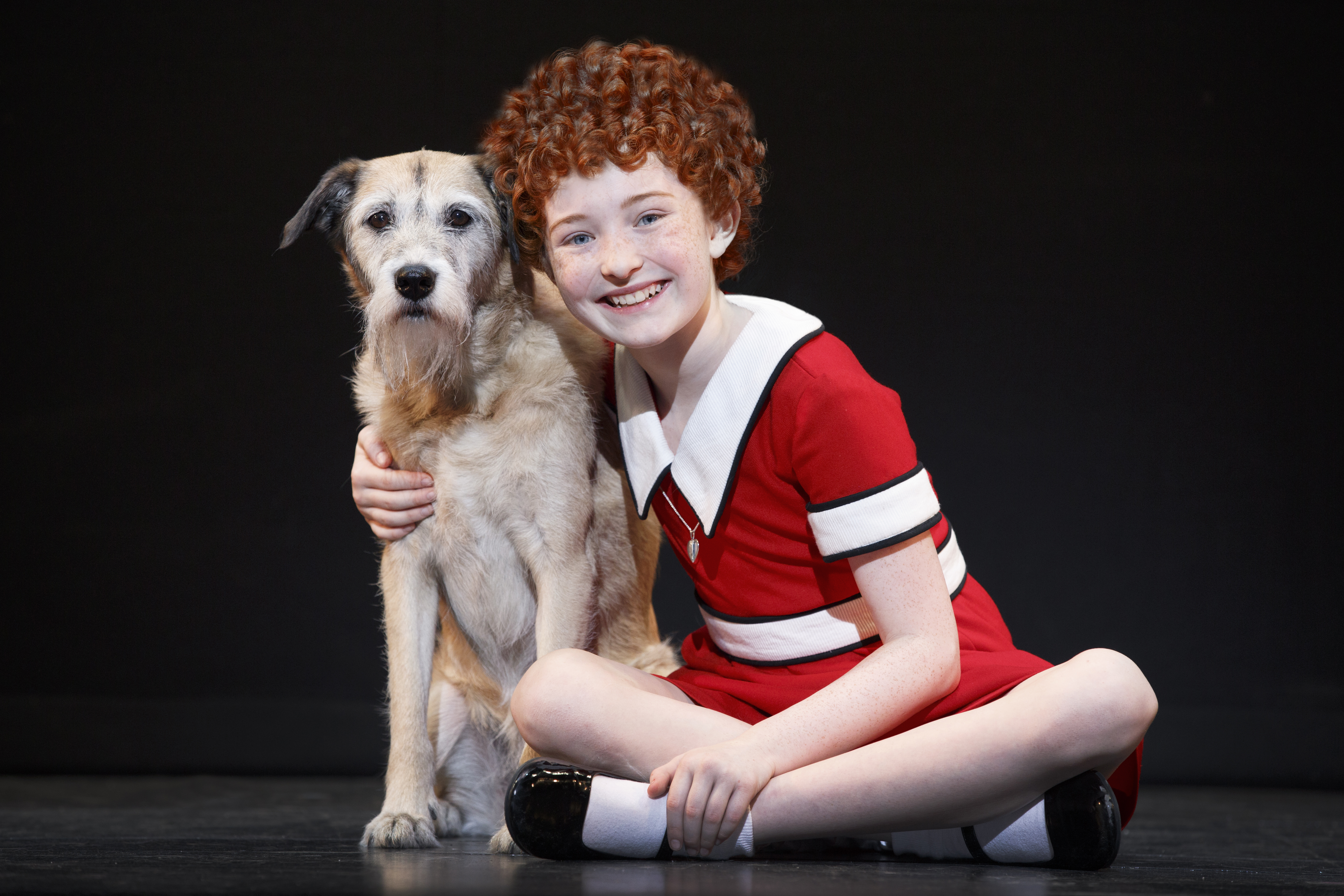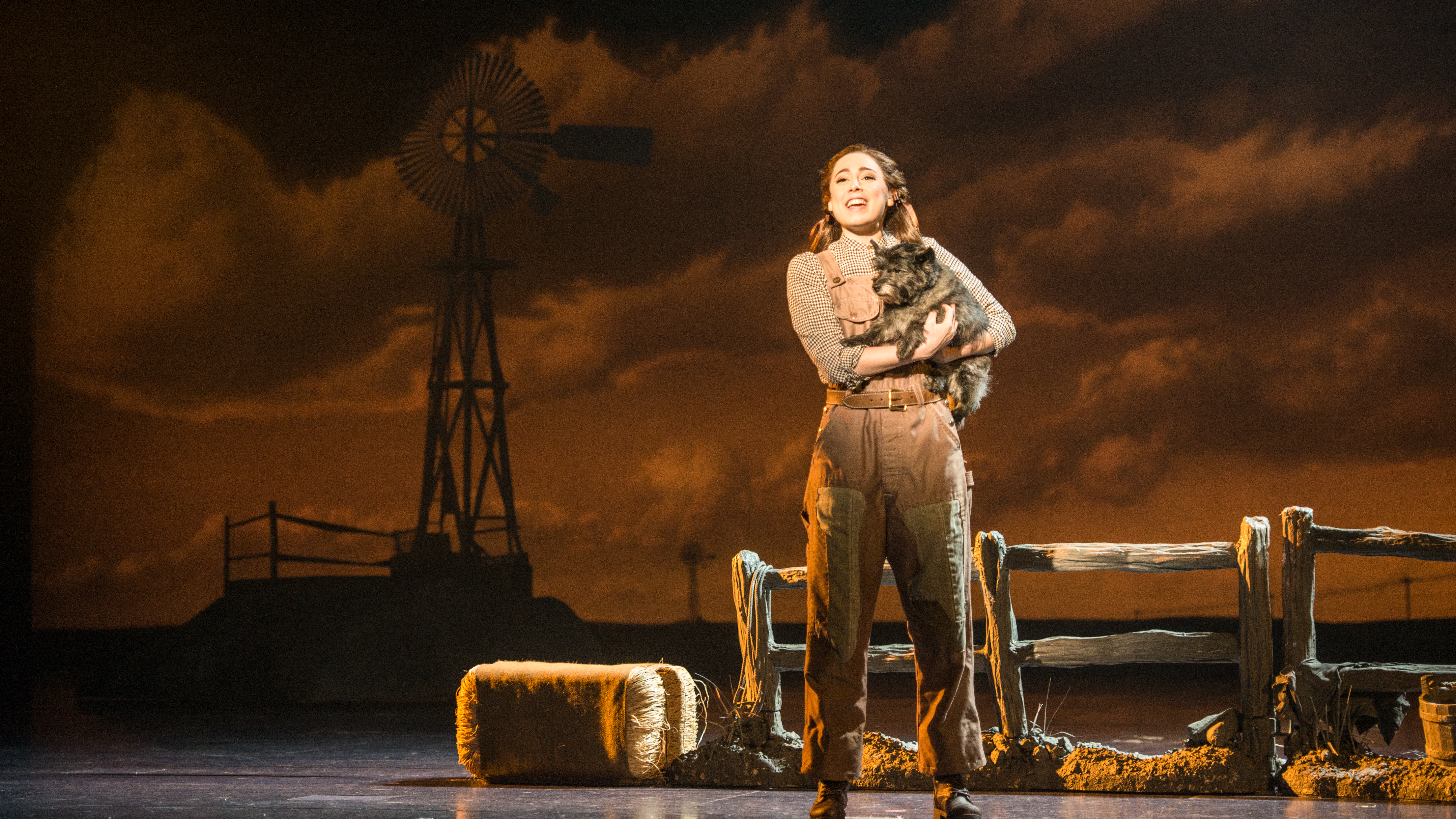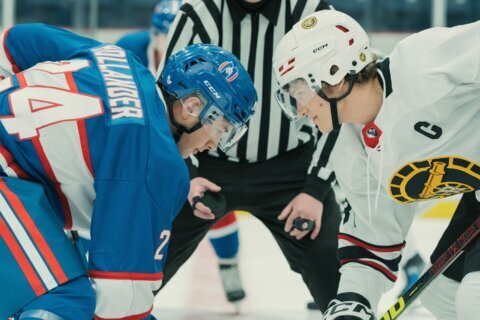WASHINGTON — A bona fide Broadway legend is in our midst.
He’s not an actor, nor a director. He’s not a playwright, composer nor choreographer.
He’s the pioneer who invented the art of training animals to perform on stage.
Wait, it gets even better — all the puppy performers are rescue animals.
That’s right. For nearly 40 years, Tony winner Bill Berloni has trained rescue and shelter animals for hundreds of stage, screen and TV productions, including a pair of spring musicals right here in D.C.
“It’s a good niche to have,” Berloni told WTOP during a recent visit to the Washington Animal Rescue League, where he raved about his carefully-trained Sandy in last month’s “Annie” and his beloved Toto in next week’s production of “The Wizard of Oz” from May 3-15 at National Theatre.
“I sign a contract that says I’m gonna make an animal do the same thing eight times a week in front of a live audience. That’s like the weatherman predicting the weather right every time, because you can’t control nature,” Berloni said. “But if you do it right … they are more consistent than the actors.”
Theatrical dog training wasn’t always his dream. How could it have been? It wasn’t invented yet.
“I was a 19-year-old star-struck kid who wanted to be an actor,” Berloni recalled.
Growing up in Connecticut, he was a theatre major at Central Connecticut State University, where he spent his free time as an apprentice at the Goodspeed Opera House in East Haddam.
“They did a new musical that needed a dog and they couldn’t afford a dog trainer. [In other words], they needed a sucker,” Berloni said. “I was given a chance to participate, to be in one of the shows, if I would find and train a dog for no money. So, being 19 and naive, I said, ‘Sure.'”
The rest is Broadway history.
“That show was the original production of ‘Annie.’ I went to a pound and adopted the original Sandy for $7. … Sandy is the first animal character that was ever written for a live theatrical event, because nobody told us we couldn’t train a dog to do the same thing eight times a week. That’s how naive I was. … A year later, we opened on Broadway in 1977 and I became a world famous animal trainer.”
It didn’t take long before he realized he had found his calling.
“I realized I was much more talented at that than at performing. So I went down that track and it’s been the best job ever,” Berloni said.
Not everyone was convinced he could pull it off, but Berloni remembered his roots.
“I grew up on a farm, I was an only child, I had pets, they were my brothers and sisters,” he said. “They played with me and stayed with me because they liked me. So I knew that animals could do repetitive behaviors if they wanted to. So when I approached ‘Annie,’ I was like, how do we make the stage fun? How do we make the dog want to go to the little girl? So we bond the little girl, they play together.”

So far, he’s managed to avoid any major doggie disasters on stage.
“We’ve never had an animal go to the bathroom on stage. Ever. We’ve had some children, but that’s another story,” Berloni joked.
“But if someone in the audience is eating fried chicken, which has happened in the front row, that’s a distraction. If someone starts whistling to the dog, if something crashes backstage, they do get distracted and off cue. But the actors are so in tune with them, they can keep them in the play without the audience knowing something is going wrong.”
In “Annie” at National Theatre, two different rescue dogs alternate playing Sandy: 7-year-old Macy and 5-year-old Sunny. Both are medium-sized terrier mutts and both cozy up to the human cast.
“They have sleepovers with the girls in the show, they travel on the same bus from city to city with the girls. They’re just these beautiful dogs anybody could have adopted the day before I did,” he said.
What are the puppy performers like offstage? Do they have stars on their trailer doors?
“They’ll get walked three times a day, so that the performance, when they get to the theatre and see their family of cast, crew, backstage people … that’s the best part of their day. That’s when they get all of their cookies and all of the love, and then they just go back to the hotel and watch TV,” he said.
As for “The Wizard of Oz,” Toto is played by lead pooch Nigel and his 3-year-old understudy Nessa.
“Our star is Nigel and he has the same sort of relationship with Dorothy. … That has to be a very close bond, because in ‘Annie,’ the dog’s only on stage for 11 minutes. In ‘Wizard of Oz,’ it’s on stage the entire performance. It goes the whole journey through Oz, so their relationship has to be really tight.”
Not only is Toto on stage for the duration, he has to perform key stunts during pivotal plot points.
“He has to run away from The Wicked Witch, he has to reveal The Wizard, he has to do all those things from the movie,” Berloni said.
However, in this stage production, you’ll notice a slight difference in the famous scene where Frank Morgan told Judy Garland and friends to “pay no attention to the man behind the curtain.”
“In this production, there is no curtain. [Toto] actually goes through a piece of scenery which sets a mechanical thing in motion and reveals The Wizard,” Berloni said. “The designer will give me the designs and we will mock them up at home and train them ahead of time to do it.”
In a show filled with doggy stunts, you might be surprised at Toto’s toughest task.
“In ‘The Wizard of Oz,’ the hardest thing the dog can do is sit still during ‘Somewhere Over the Rainbow.’ When you think about what ‘Oz’ is about and that iconic image of Judy Garland, if the dog is sitting there scratching and looking around, the audience is giggling. So we really need that relationship zeroed in to Dorothy. That’s the hardest cue, because everything else is fun.”

Berloni says the live theatre process is much different from training dogs for movies (i.e. “Old Yeller”) or television (i.e. Eddie on “Frasier”) — two mediums in which he dabbles from time to time.
He was recently tapped by NBC to train the dogs for “Peter Pan: Live” and “The Wiz: Live.” In the former, Nana was played by Bodie, a big poodle mix with hair grown out to look like a sheep dog. In the latter, Toto was played by two brand-new, beige-colored terriers that Berloni adopted.
“That was even crazier,” Berloni said. “Let’s put a dog in front of 10 million people, and if you fail, you fail big. I mean, in a stage production you could fail in front of 1,500, but live television?”
While he enjoyed both experiences, Berloni still prefers the live theatre atmosphere to film or TV.
“I could go to Hollywood and make a lot of money, but it’s not as much fun as theatre. Theatre is a family, theatre is a community, it’s an experience where every night I can let go of a dog and hear an audience enjoy it. When you do a film, it’s cut, print, and you never see what an audience does.”
This quest for that live theatre rush has included D.C. right from the start.
“When ‘Annie’ opened in 1976 at the Goodspeed Opera House, the pre-Broadway tryout was in Washington D.C. at the Kennedy Center. So Washington has a very special place in my heart. … And you have [two] of the best animal welfare groups combining to work on rescue here.”
He, of course, is discussing the Washington Human Society and the Washington Animal Rescue League, which recently merged into one facility on Oglethorpe St. in Northwest D.C.
“One of the things we really struggle with is … people think something is wrong with an animal that shows up in a shelter. Most of the time, what’s wrong with them is just bad luck in their human family. It’s nothing to do with the animal,” said Lisa LaFontaine, president and CEO of both rescue groups.
“The fact that Bill takes these guys out of rescue, out of shelters and then shows their true personality and spirit and lets them live the life they were meant to, it makes a real statement to people that rescue animals are great and wonderful and deserve a second chance.”
Berloni says training rescue dogs is not so different from training other domestic dogs.
“Sometimes there are issues left over from their prior life that we have to rehabilitate, but ultimately when you rescue a dog, they are so appreciative that they’ll give it their all,” he said. “Whether you’re me who’s asking them to perform, or just a homeowner, a rescue dog is the way to go.”
Rescuing animals has become as big a passion for Berloni as the live theatre performances. Macy hails from Dalmatian Rescue of Oklahoma City; Sunny from the Houston Animal Welfare League; Nigel from the Arkansas Human Society; and Nessa from Cairn Rescue USA based out of New York.
“Ask me my wife’s birthday and anniversary, I can’t remember,” Berloni laughed. “But my dogs …”
Now, Berloni and his wife live on a 90-acre farm in Connecticut. It’s here that his beloved performing pooches retire after their theatre days are over, roaming free on a bigger, greener stage. If you listen closely, you can hear them bark, “There’s no place like home.”
“We have 30 dogs in our house and they’re all rescue dogs,” Berloni said. “I’ve rescued over 300, because I just made that promise I would always use rescue dogs.”
Berloni is now bathing in good karma as the Daddy Warbucks to these four-legged Orphan Annies.
“I was honored with a Tony Honor for Excellence in Theatre … because I’ve been the only one who’s been training animal performances,” Berloni said. “I’ve written books and we have a reality show and we have a 90-acre farm in Connecticut, all because I showed a little kindness to a dog back in 1976.”
Listen to the full interview with Broadway animal trainer Bill Berloni below:








